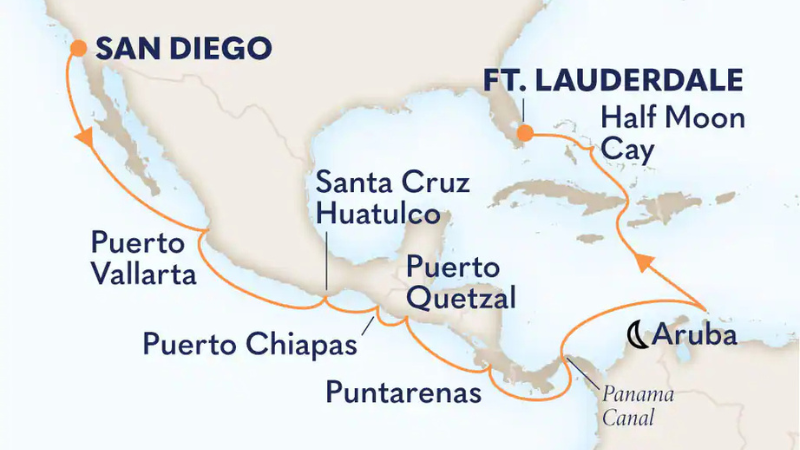If you’ve been poking around cruise line websites or chatting with seasoned cruisers, you might’ve stumbled across the term “repositioning cruise.” It sounds intriguing, maybe even a little mysterious, right? What exactly is it, and is it something you should add to your cruise list? Let’s dive in, unpack what a repositioning cruise is, and weigh the pros and cons so you can decide if it’s your kind of adventure.
So, What’s a Repositioning Cruise?
Cruise ships are like Florida snowbirds—they don’t always stay in one place. When the seasons change, cruise lines move their ships from one region to another to chase better weather or tap into peak travel seasons. For example, a ship might spend the summer cruising the Mediterranean and then head to the Caribbean for the winter. The voyage that gets the ship from Point A to Point B? That’s a repositioning cruise!
These cruises are one-way trips, often crossing oceans or covering long distances, and they don’t follow the usual round-trip itinerary. Think of it as the ship’s “road trip” to its next home base. You might sail from Barcelona to Miami, Southampton to Sydney, or even Vancouver to Tokyo. They typically happen in the spring and fall, when ships are on the move between their seasonal stomping grounds.

The Pros of a Repositioning Cruise
Now that you’ve got the gist, let’s talk about why these cruises can be a total win.
- Unbeatable Value – Repositioning cruises are often priced lower than standard cruises—sometimes way lower. Since they’re one-way and less predictable, they’re harder for cruise lines to fill. To sweeten the deal, they slash prices. You might snag a 14-day transatlantic cruise for the cost of a week-long Caribbean one. For budget-conscious cruisers who want more bang for their buck, this is a no-brainer.
- Unique Itineraries – If you’re the type who loves checking off new destinations, repositioning cruises deliver. They often stop at off-the-beaten-path ports that don’t make it onto standard itineraries. Some hidden gems might pop up on your route, plus, transoceanic voyages give you a chance to cross an ocean without stepping foot on a plane—and with air travel today, that’s a huge win!
- Sea Days Galore – Are you one who loves sea days? If so, repositioning cruises could be just what you’re looking for. With long stretches between ports, you’ll have plenty of time to soak up the ship’s amenities.
- A Different Vibe – These cruises attract a unique crowd—seasoned travelers, adventure seekers, and folks who love the journey as much as the destination. The vibe is often more relaxed, with fewer families and a focus on the experience rather than a packed excursion schedule.
The Cons of a Repositioning Cruise
Of course, no cruise is perfect, and repositioning cruises come with a few quirks you’ll want to consider.
- One-Way Travel – Since these cruises don’t loop back to the starting port, you’ll need to figure out how to get to the departure port and home from the arrival port. This can mean pricey one-way flights or extra travel planning. For example, if you’re sailing from Rome to Fort Lauderdale, you might need to budget for a flight to Italy and one back from Florida. It’s doable, but it adds complexity and expense.
- Fewer Port Days – If you’re all about exploring new cities, repositioning cruises might feel light on action. With more sea days, you’ll spend less time ashore compared to a typical cruise. Some folks love this, but if you prefer daily excursions, you might find the pace a bit slow.
- Unpredictable Weather – Crossing an ocean or traveling long distances can mean unpredictable weather, especially on transatlantic or transpacific routes. Rough seas or chilly days might limit your time on deck. If you’re prone to seasickness or hate being cooped up indoors, check the route and season carefully.
- Definitely Not for First-Timers – Repositioning cruises are a bit unconventional, so they might not be the best intro to cruising. If you’re new to the game, you might prefer a shorter, round-trip cruise to get your sea legs before committing to a long, one-way voyage.
Is a Repositioning Cruise Right for You?
So, should you book that repositioning cruise? If you love a good deal, crave unique experiences, and don’t mind a bit of extra planning, it could be your dream trip. They’re perfect for retirees, remote workers, or anyone with the time and flexibility to embrace a longer journey. On the flip side, if you’re short on time, love action-packed port days, or dread logistics, you might want to stick with a classic cruise.
My advice? Do your homework. Check the itinerary to make sure the ports excite you, budget for travel to and from the ship, and pack some Dramamine just in case. Most importantly, embrace the adventure! A repositioning cruise is a chance to see the world from a new perspective, meet fellow wanderers, and make memories that’ll last a lifetime.
